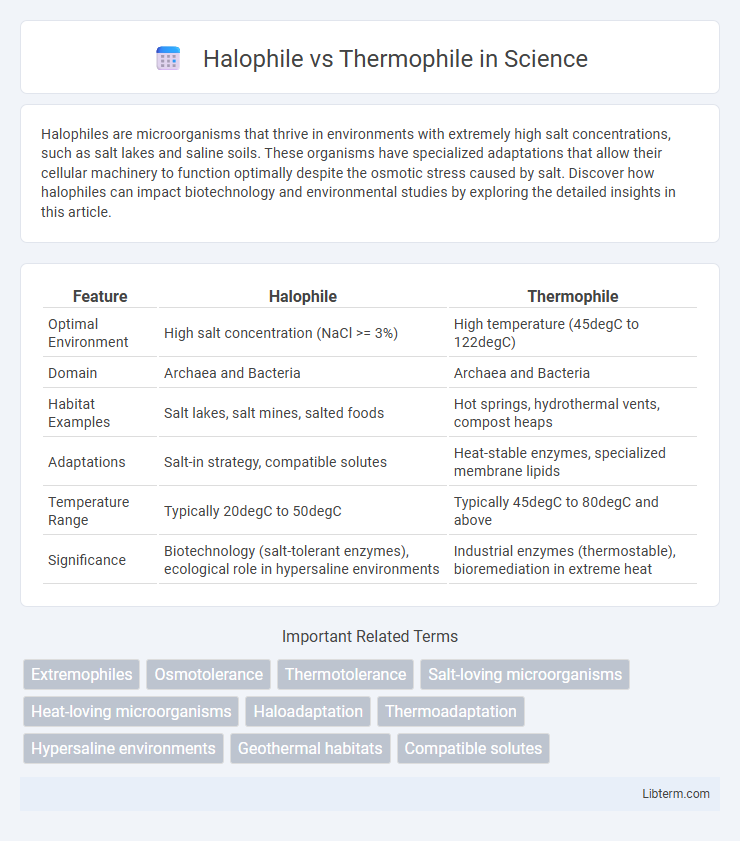Halophiles are microorganisms that thrive in environments with extremely high salt concentrations, such as salt lakes and saline soils. These organisms have specialized adaptations that allow their cellular machinery to function optimally despite the osmotic stress caused by salt. Discover how halophiles can impact biotechnology and environmental studies by exploring the detailed insights in this article.
Table of Comparison
| Feature | Halophile | Thermophile |
|---|---|---|
| Optimal Environment | High salt concentration (NaCl >= 3%) | High temperature (45degC to 122degC) |
| Domain | Archaea and Bacteria | Archaea and Bacteria |
| Habitat Examples | Salt lakes, salt mines, salted foods | Hot springs, hydrothermal vents, compost heaps |
| Adaptations | Salt-in strategy, compatible solutes | Heat-stable enzymes, specialized membrane lipids |
| Temperature Range | Typically 20degC to 50degC | Typically 45degC to 80degC and above |
| Significance | Biotechnology (salt-tolerant enzymes), ecological role in hypersaline environments | Industrial enzymes (thermostable), bioremediation in extreme heat |
Introduction to Extremophiles
Extremophiles are microorganisms adapted to survive in extreme environmental conditions, with halophiles thriving in high-salt environments and thermophiles in high-temperature habitats. Halophiles, such as Halobacterium species, maintain cellular function in salinities exceeding 20%, while thermophiles like Thermus aquaticus flourish at temperatures above 60degC. These adaptations involve specialized proteins and membrane structures that enable stability and enzymatic activity under extreme osmotic or thermal stress.
What Are Halophiles?
Halophiles are extremophilic microorganisms that thrive in environments with high salt concentrations, typically above 20% sodium chloride. They possess specialized cellular mechanisms, such as salt-in strategies and compatible solutes, enabling them to maintain osmotic balance and structural stability in hypersaline habitats like salt lakes, salt mines, and saline soils. Unlike thermophiles, which prefer high-temperature environments, halophiles are uniquely adapted to survive and grow in intensely saline conditions.
What Are Thermophiles?
Thermophiles are microorganisms that thrive at high temperatures, typically between 41degC and 122degC, often found in environments like hot springs and hydrothermal vents. These heat-loving organisms possess specialized proteins and enzymes that remain stable and functional under extreme heat, enabling unique metabolic processes. Unlike halophiles, which require high salt concentrations, thermophiles are adapted specifically to withstand and proliferate in elevated thermal conditions.
Environmental Adaptations of Halophiles
Halophiles thrive in hypersaline environments by accumulating compatible solutes like potassium chloride to balance osmotic pressure and prevent dehydration. Their cellular proteins and enzymes exhibit structural adaptations allowing stability and functionality in high-salt conditions. These organisms also possess specialized ion pumps and membrane lipids that maintain cellular homeostasis under extreme salinity.
Environmental Adaptations of Thermophiles
Thermophiles thrive in extreme heat environments, such as geothermal springs and deep-sea hydrothermal vents, by possessing heat-stable enzymes and specialized membrane structures that maintain cellular integrity at high temperatures. Their proteins exhibit enhanced thermostability, allowing metabolic processes to continue efficiently without denaturation in temperatures often exceeding 70degC. These adaptations contrast with halophiles, which primarily require high salt concentrations for survival rather than extreme heat tolerance.
Key Differences Between Halophiles and Thermophiles
Halophiles thrive in high-salt environments, typically requiring salt concentrations above 15%, whereas thermophiles grow optimally at high temperatures ranging from 45degC to 122degC. Halophiles possess specialized cellular mechanisms like compatible solutes to maintain osmotic balance, while thermophiles have heat-stable enzymes and proteins adapted to prevent denaturation under extreme heat. Differences in habitat, cellular adaptations, and environmental tolerances underline the distinct ecological niches and evolutionary paths of halophiles versus thermophiles.
Ecological Roles of Halophiles and Thermophiles
Halophiles play crucial ecological roles in hypersaline environments by participating in nutrient cycling, promoting the degradation of organic matter, and supporting unique microbial communities that influence salt marsh and salt lake ecosystems. Thermophiles contribute significantly to nutrient turnover in extreme high-temperature habitats such as hot springs and hydrothermal vents, where they facilitate the breakdown of organic compounds and drive primary production through chemosynthesis. Both halophiles and thermophiles are essential in maintaining ecosystem stability and biogeochemical cycles in their respective extreme environments.
Industrial Applications of Halophiles
Halophiles thrive in high-salt environments and produce enzymes and biopolymers resistant to salt and extreme conditions, making them valuable for industries such as bioremediation, pharmaceuticals, and food processing. Their unique metabolic pathways enable the production of compatible solutes like ectoine, used for skin care and stress protection in biotechnology. Industrial applications leverage halophiles for biofuel production and biodegradable plastics, optimizing processes under hypersaline conditions where conventional organisms fail.
Industrial Applications of Thermophiles
Thermophiles thrive in high-temperature environments, making their enzymes highly stable and efficient for industrial processes such as biofuel production, waste treatment, and pharmaceuticals. Their thermostable enzymes, like Taq polymerase, revolutionize DNA amplification techniques in molecular biology and diagnostics. Industrial sectors leverage thermophilic microorganisms to enhance reaction rates and reduce contamination risks due to their ability to operate at elevated temperatures.
Future Prospects in Extremophile Research
Halophiles and thermophiles represent key extremophiles with unique adaptations to high salt and temperature environments, respectively, offering promising avenues for biotechnological innovation and sustainable industrial applications. Future prospects in extremophile research emphasize genetic engineering to enhance enzyme stability and efficiency under extreme conditions, enabling breakthroughs in biofuel production, pharmaceutical synthesis, and environmental remediation. Advances in omics technologies and synthetic biology are expected to accelerate the discovery and utilization of novel extremozymes from halophiles and thermophiles, paving the way for next-generation bioprocesses.
Halophile Infographic

 libterm.com
libterm.com